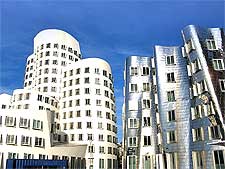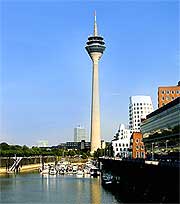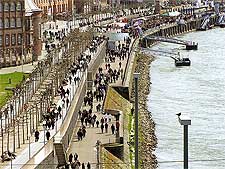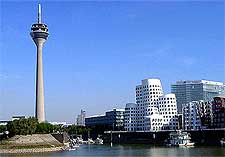Dusseldorf History Facts and Timeline
(Dusseldorf, North Rhine-Westphalia, Germany)

Dusseldorf is said to have emerged in the 7th or 8th centuries from the tiny farming and fishing villages that grew up around the meeting place of the Rhine River and the Dussel River. Indeed, its name is derived from the name of its river and 'dorf', which means 'village'.
The earliest written records of Dusseldorf, however, date back to the 12th century. In 1186, Dusseldorf came under the control of the Dukes of Berg. The closing decades of the 13th century were to be highly significant for the town. In 1288, it was given city status by Count Adolf V von Berg following an earlier defeat of the Archbishop of Cologne's army at Worringen. The Stadterhebungs Monument was built to commemorate the event - it can still be seen here today.
By the 14th century, Dusseldorf had developed into a small city that had grown up under the shadows of a defensive wall. In 1380, it rose to become the regional capital of the Duchy of Berg. During the years that followed, Dusseldorf grew at a rapid rate. Buildings that date to this period of the city's history include the Church of St. Lambertus.

Early Modern History
In the 16th century, Dusseldorf's position in Germany was consolidated further when a castle was built here on the orders of Duke Wilhelm. In the early 1570s, a Town Hall was also built in the city.
Then, in 1609, a power struggle ensued as a result of the Berg family line finally coming to an end. Dusseldorf eventually fell to the Wittelsbach counts of the territory known as Palatinate Neuburg, who made this their main place of residence. From 1614, the city was the capital of the Palatinate.
Dusseldorf grew at an impressive rate during the 18th century. Its success owed a great deal to Duke Johann Wilhelm II and his wife Anna Maris Luisa de Medic. The duke was actually born here in 1658, and later died in the city in the year of 1716. Under the duke's leadership, the city became a flourishing royal residence and cultural city.

From the 19th Century to the Present Day
The mid-19th century saw the arrival of the Industrial Revolution in the city. Its population doubled between 1882 and 1892, when it was called home by more than 200,000 inhabitants.
During World War Two history, Dusseldorf suffered considerable bombing damage, mainly as a consequence of the British aerial bombardment campaign aimed at Germany's Ruhr industries. In April 1945, US forces captured the city, after meeting little in the way of local resistance.

In 1946, Dusseldorf became the capital city of a new state known as North Rhine-Westphalia. During the post-war years, it managed to recover a great deal of its former grandeur, particularly in terms of its most significant historic buildings.
In more recent years, Dusseldorf's population has remained relatively stable at around 600,000. Its modest size belies its importance as a centre of industry, however, with many international companies choosing to set up their businesses here. The numerous annual trade fairs staged at the Messe Exhibition Centre (founded in 1947) are a particular success story.
 Dusseldorf is said to have emerged in the 7th or 8th centuries from the tiny farming and fishing villages that grew up around the meeting place of the Rhine River and the Dussel River. Indeed, its name is derived from the name of its river and 'dorf', which means 'village'.
Dusseldorf is said to have emerged in the 7th or 8th centuries from the tiny farming and fishing villages that grew up around the meeting place of the Rhine River and the Dussel River. Indeed, its name is derived from the name of its river and 'dorf', which means 'village'.

 In 1946, Dusseldorf became the capital city of a new state known as North Rhine-Westphalia. During the post-war years, it managed to recover a great deal of its former grandeur, particularly in terms of its most significant historic buildings.
In 1946, Dusseldorf became the capital city of a new state known as North Rhine-Westphalia. During the post-war years, it managed to recover a great deal of its former grandeur, particularly in terms of its most significant historic buildings.